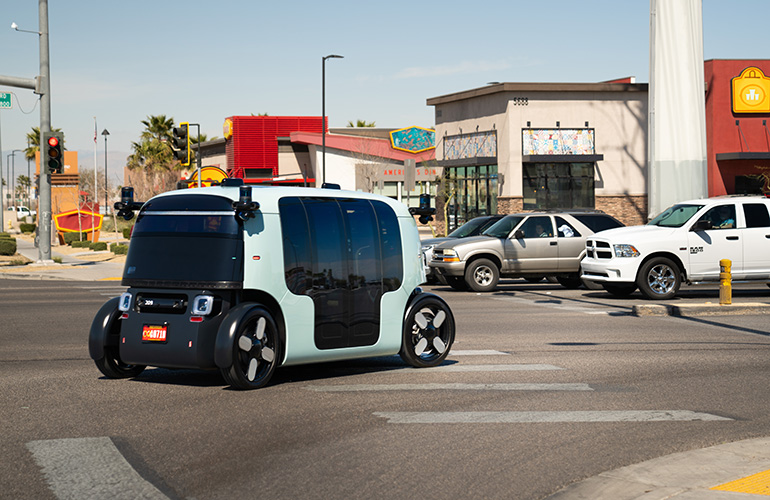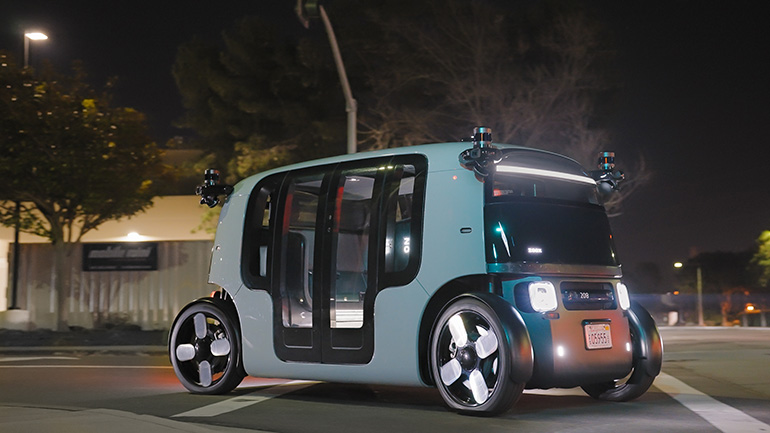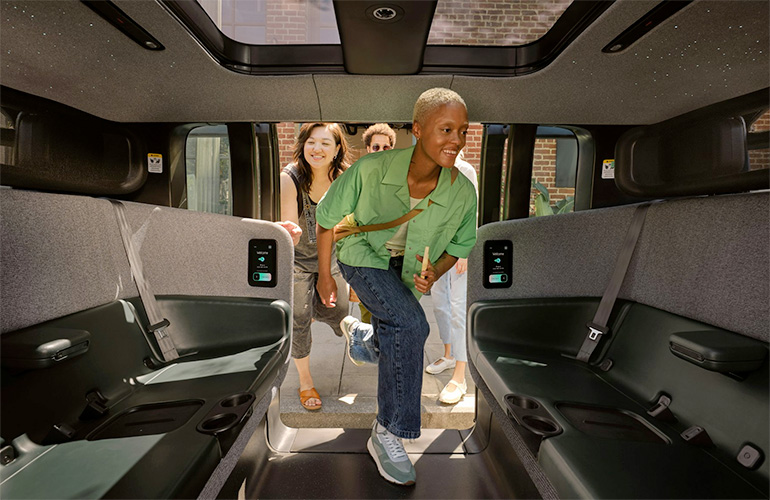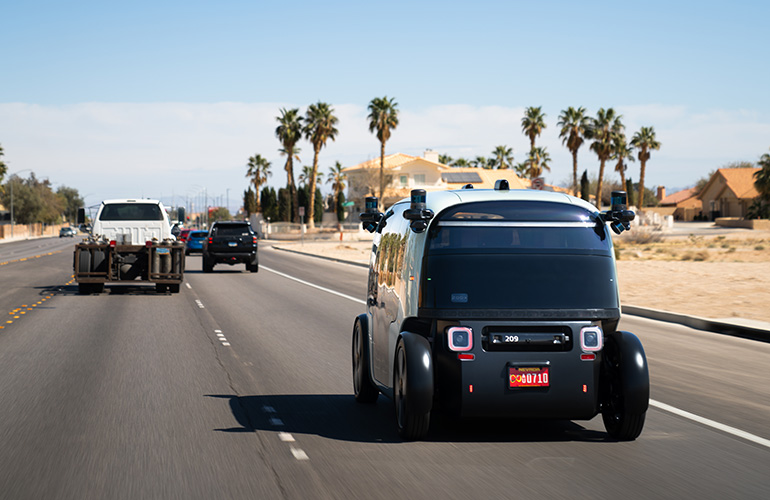|
Listen to this article |

Zoox is expanding the geofence for its operations in Las Vegas. | Credit: Zoox
Over the past year, Zoox Inc. has made significant progress on its autonomous robotaxi service roadmap.
In February, the Amazon.com subsidiary announced that it completed a key milestone: deploying its robotaxi on open public roads with passengers.
In the shadow of the disappointing news from competitor Cruise, which lost its autonomous operating permit from the California Department of Motor Vehicles (DMV), closed its San Francisco service, and laid off 900 employees, Zoox completed rigorous testing on private roads. It received approval from the California DMV to operate its robotaxi on the state’s public roads.
On the way, Zoox has invested heavily in simulation tools necessary to train the robot drivers to handle any on-road situation. Simulation is the key to safely training AI models and logging thousands of hours of drive time without endangering anyone.
“One [key to our success] is obviously through our test vehicle logged miles,” said Qi Hommes, senior director of system design and mission assurance at Zoox. “We drive our test vehicles with safety drivers quite a bit in our launch-intent areas. And anytime we encounter something unexpected, those are inputs into the development of those simulation scenarios.”
Zoox begins service for employees in California
Zoox claimed that it is the only purpose-built robotaxi permitted on California public roads that is self-certified to the Federal Motor Vehicle Safety Standards (FMVSS). The company recently deployed its employee shuttle service in its headquarters in Foster City, Calif. Zoox will offer the shuttle service exclusively to all full-time employees.
“Becoming the first company to operate a purpose-built robotaxi with passengers on open public roads in California is a significant milestone in not only Zoox’s journey, but [also] for the autonomous vehicle industry at large,” stated Aicha Evans, CEO of Zoox, after the DMV approval. “With the announcement of the maiden run of our autonomous employee shuttle, we are adding to the progress this industry has seen over the last year and bringing Zoox one step closer to a commercialized purpose-built robotaxi service for the general public.”
Unlike robotaxi competitors relying on car chassis, Zoox said it has designed its platform from the ground up for autonomous passenger movement. Every design decision was made with the goal of providing a comfortable, interactive experience.
The most obvious difference between Zoox and competitors like Waymo and Cruise is that the Zoox vehicle is missing a steering wheel. It has large doors on both sides of the vehicle and seats up to four passengers, with the riders sit facing one another.

The Zoox autonomous robo-taxi vehicle is omnidirectional and uses four-corner steering. There is no onboard safety driver. | Credit: Zoox
A rider’s view of the robotaxi
At CES 2024, I interviewed Chris Stoffle, director of industrial and creative design at Zoox, and got a tour of the vehicle on the show floor.
The first thing that I noticed was how quiet it was inside the vehicle. CES is a noisy place. The cacophony of tens of thousands of people talking can be overwhelming, and inside the Zoox vehicle, it was quiet and comfortable.
Stoffle described the Zoox rider experience: “Right now, we’re inside a robotaxi designed from the ground up to provide the best rider experience. The outside of the vehicle has a smaller footprint than a BMW i3. But inside we have this large space where passengers can sit comfortably across from each other. There’s no bad seat in the vehicle. Each rider can see the map, and adjust the temperature for their seat. In addition, there are USB power ports, drink holders, task lights, and an emergency button to contact help immediately.”

Inside of the Zoox robotaxi, each rider has their own comfort controls while facing one anther for the ride. | Credit: Zoox
Las Vegas operations expand to five-mile radius
Since its February announcement, Zoox has expanded the geofence for its Las Vegas fleet of robotaxis, expanding the operational area for moving employees as they test the service. The new geofence is a five-mile radius around the company’s Las Vegas headquarters.
The new service area is more complex and includes three-lane roads, harder lane changes, unprotected right turns onto high-speed roadways, and double-right and left-hand turn lanes.
The robotaxis are now handling more difficult operating situations as the engineering team validates the features and safety of the vehicle operation. In addition, the autonomous vehicles are now driving at speeds of up to 45 mph, in light rain, and at night.
The fact that the vehicles have no steering wheel and no onboard safety driver means that the Zoox team has to monitor each vehicle in real-time. These “human-in-the-loop” operators do not teledrive the vehicles, but they do monitor each ride in real time, looking at the environment and the vehicle’s intentions as it decides to turn, stop, and move through intersections.
If there is an emergency situation, the remote operator can direct the vehicle how to respond and where to go to safely resolve the situation.
“[Zoox’s vehicle] was approved to drive on public roads last year and now is fully homologated in response to emergency vehicles being able to detect them,” explained Stoffel. “Being able to interact with humans outside the vehicle in safe ways is really important. And so we’ve been able to not only update our sensor pod to improve self-driving in inclement weather with some of our sensor cleaning, but also to bring in a better microphone designed on the exterior so we can detect sirens and first-responder vehicles earlier.”
“The door interface module allows us to interact with those outside the vehicle with the human in the loop, whether it be a rider, someone from the public, or even a first responder,” he added. “We believe that being able to have that human in the loop is the right approach for those off-nominal situations that we’re going to be seeing more and more as we expand on public roads.”
To hear about the development of the perception engine and sensor stack used on the Zoox vehicle, listen to the podcast interview with two of the company’s technology leaders: RJ He and Ryan McMichael.

Zoox is incrementally increasing the parameters for operation of its fleet of robotaxis in Las Vegas. | Credit: Zoox





